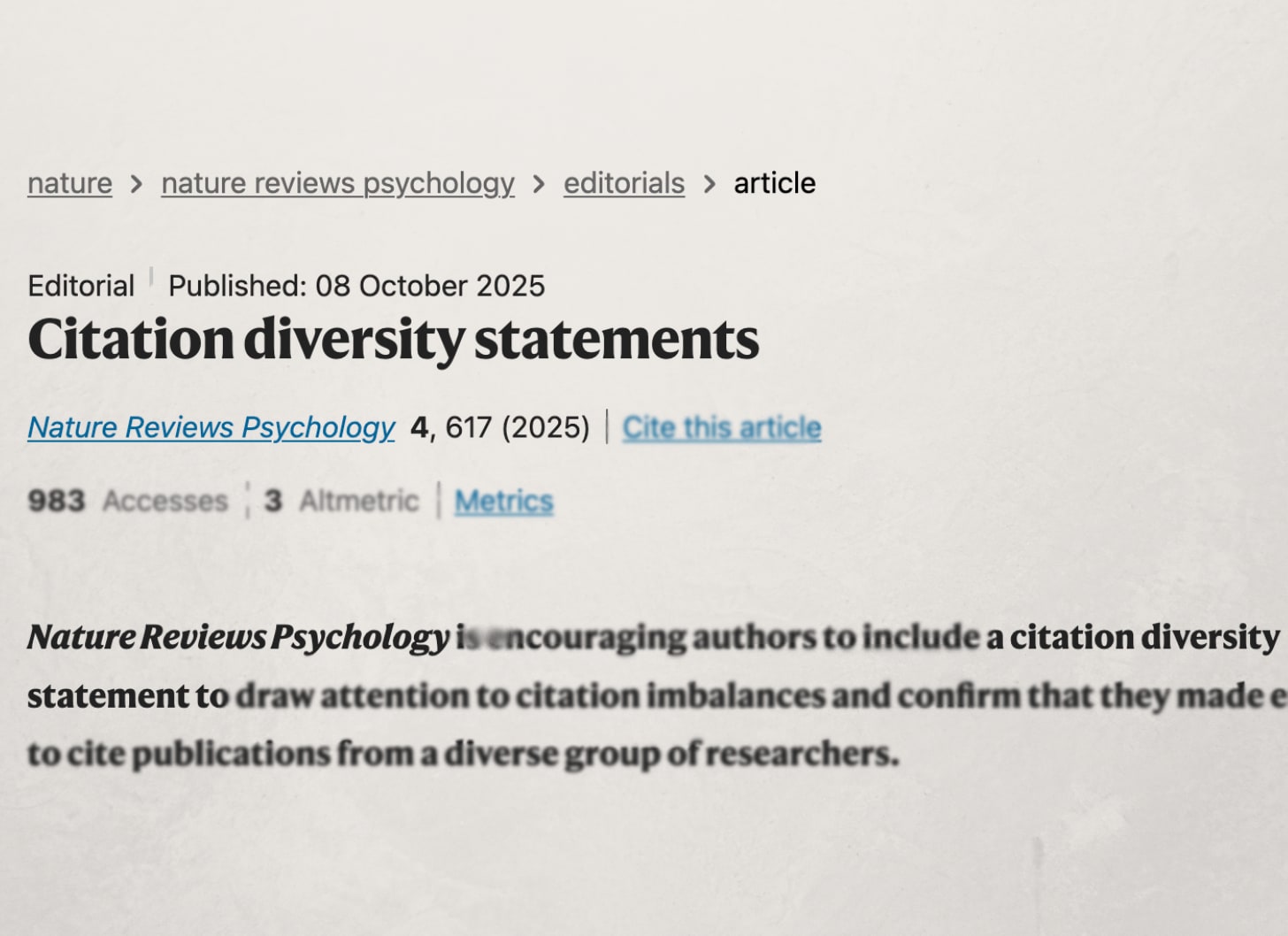Within academia, a new metric of “diversity” may be gaining traction—not in admissions, faculty hiring, or funding, but in the references of research. Nature Reviews Psychology shared their new journal guidelines on “citation diversity statements” in which authors should “draw attention to citation imbalances” among scientists from different demographic backgrounds, and “confirm that they made efforts to cite publications from a diverse group of researchers.” Unfortunately, citation diversity statements reduce scholars to statistics, threaten academic rigor, and add yet another ideologically conformist hoop for academics to jump through.
Nature Reviews Psychology editors ask authors to describe how they “explore[d] relevant studies from a diverse group of researchers (including but not limited to diversity in gender, race, career stage and geographical location) before writing their first draft.” The editors suggest these optional citation diversity statements are a way that “scientists can demonstrate their commitment to DEI through actions that are not mandated by institutions or subject to institutional control.” In other words, authors are expected to remain steadfastly committed to the same principles that the federal government is attempting to aggressively quash within universities.
Citation diversity statements prompt authors to consider the demographics of their cited sources in the pursuit of representational equity. In doing so, they risk sacrificing truth and knowledge seeking at the altar of DEI. And they certainly win the academy no favor at a time when public trust is in short supply.
Nature Reviews Psychology’s decision to encourage citation diversity statements appears to be the latest in a small yet noteworthy movement to embed equity goals explicitly in the scientific publishing process. Several papers have advocated for the practice, and a small number of journals have adopted optional citation diversity statement requests as a part of their article submission processes. Nature Reviews Bioengineering, a sister publication of Nature Reviews Psychology, may have served as an early pilot of the citation diversity statement with Nature after it adopted such a policy in 2023.
The Biomedical Engineering Society (BMES) was an early adopter of citation diversity when, in 2021, editors integrated an optional citation diversity statement into the article submission process for its four journals, Annals of Biomedical Engineering, Cellular and Molecular Bioengineering, Cardiovascular Engineering and Technology, and Biomedical Engineering Education.
BMES editors followed the suggestions of citation diversity advocates to straightforwardly ask authors to tally up diversity points. Authors opting into the diversity statement are asked specifically for “the proportion of citations by gender and race/ethnicity for the first and last authors” and “the method used to determine those proportions and its limitations.”
BMES even provides detailed instructions on how proportions should be presented: “The proportions of authors by gender should be divided into four categories based on first/last author combinations: woman/woman, man/woman, woman/man, and man/man. Race and ethnicity proportions should similarly be divided into four categories based on first/last author combinations: author of color/author of color, white author/author of color, author of color/white author, white author/white author.” This numeric scheme raises many unanswered questions about target proportions, cross-cutting identities, and whether authors are deciding which scholars to reference based on perceived demographics rather than scholarly ideas and data presented in their papers.
Also in 2021, scientific publisher Cell Press shared its Inclusion and Diversity Statement guidelines, which suggested that authors can address “efforts made to promote gender balance in citation lists” in their optional DEI statement. (Cell Press editors later paused these efforts in 2023.)
Authors aren’t the only ones being asked to consider the equity of references. Review of International Studies from Cambridge University Press briefly directs article reviewers to consider the “representativeness of citation practices” of submitted articles.
Proponents of citation diversity, also referred to as “citation justice,” point to research arguing that female authors and authors of color are under-cited relative to their share of the field. But even accepting such claims at face value brings up serious questions about what practical implementation of citation diversity means for the reputations of all involved.
Prompting scholars to consider author demographics as they develop their reference lists threatens scholarly rigor. Instead of grappling with the complexity of arguments, theories, and data presented by fellow researchers, academics may find themselves Googling photos of scholars they might cite to see if they can (literally) get more diversity tallies in their reference list to appease the journal. Consequently, the actual accomplishments of scholars, many of whom may have indeed worked very hard to overcome obstacles, risk being tokenized by identitarian orthodoxies.
Some editors point to the innovation boom that can arise from exploring the work of lesser-known scholars, who may be more likely to be non-white and non-male. The editors of Nature Reviews Bioengineering shared that “we believe that by including a citation diversity statement, our authors will thoughtfully pick their references, taking the time to survey the entire field, rather than citing the same authors or institutions repeatedly… Importantly, this will improve our Review articles as the discussion will truly outline the current state, challenges and innovations of a field.”
Engaging with a variety of ideas, texts, and research from an array of scholars across the field is essential to the spirit of the academy and scholarship itself—not to mention necessary for knowledge production. It should be second nature for academics to wade deeply into the literature of their disciplines. As Erec Smith observed last year regarding Nature Reviews Bioengineering’s reasoning for requesting citation diversity statements, “... thoughtfully choosing references and giving sufficient time to survey an entire field is already considered a significant part of scientific research, academic discourse, and critical thinking in general. If scientists are not doing this, the problem isn’t that they are biased; it’s that they are bad scientists.” References should be included in an article because of the ideas within them, not because of the skin color or gender identity of the writers.
Much like DEI statements in faculty hiring, citation diversity statements function as another ideological filter that forces academics to contort themselves and their professional pursuits into ideologically palatable shapes. In explicitly asking authors and reviewers to consider the demographic characteristics of cited sources (and tally them up for presentation), these journals jeopardize the scholarly rigor of scholars and of the journals themselves, which, for better or worse, are the cornerstone of scholarly dissemination.
In theory, citation diversity aims to broaden representation; in practice, it reduces scholarship to a superficial numbers game. True intellectual diversity emerges when scholars engage deeply with the best ideas, wherever they originate—not when journals ask researchers to audit the demographics of their bibliographies. If the goal is to advance science, then intellectual rigor, not ideological conformity, must be the guiding principle.
.png)




